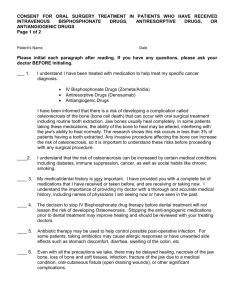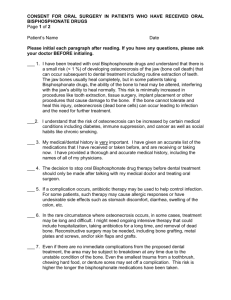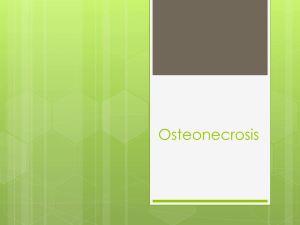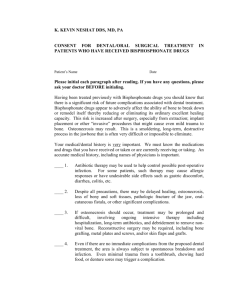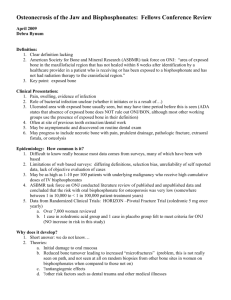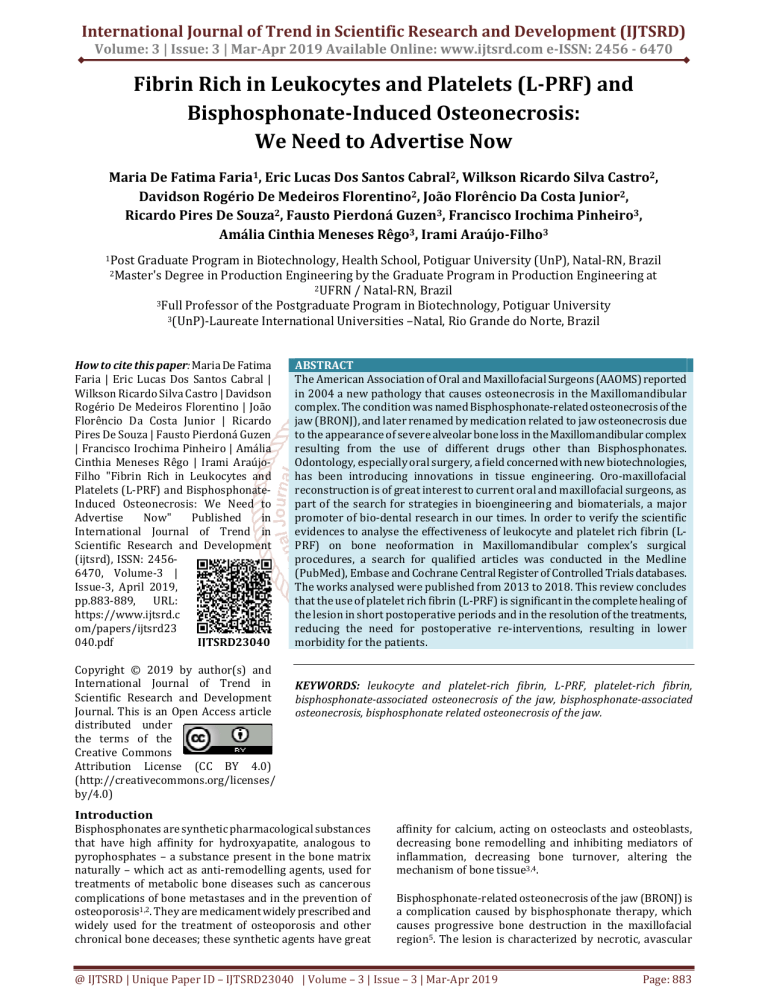
International Journal of Trend in Scientific Research and Development (IJTSRD)
Volume: 3 | Issue: 3 | Mar-Apr 2019 Available Online: www.ijtsrd.com e-ISSN: 2456 - 6470
Fibrin Rich in Leukocytes and Platelets (L-PRF) and
Bisphosphonate-Induced Osteonecrosis:
We Need to Advertise Now
Maria De Fatima Faria1, Eric Lucas Dos Santos Cabral2, Wilkson Ricardo Silva Castro2,
Davidson Rogério De Medeiros Florentino2, João Florêncio Da Costa Junior2,
Ricardo Pires De Souza2, Fausto Pierdoná Guzen3, Francisco Irochima Pinheiro3,
Amália Cinthia Meneses Rêgo3, Irami Araújo-Filho3
1Post
Graduate Program in Biotechnology, Health School, Potiguar University (UnP), Natal-RN, Brazil
Degree in Production Engineering by the Graduate Program in Production Engineering at
2UFRN / Natal-RN, Brazil
3Full Professor of the Postgraduate Program in Biotechnology, Potiguar University
3(UnP)-Laureate International Universities –Natal, Rio Grande do Norte, Brazil
2Master's
How to cite this paper: Maria De Fatima
Faria | Eric Lucas Dos Santos Cabral |
Wilkson Ricardo Silva Castro | Davidson
Rogério De Medeiros Florentino | João
Florêncio Da Costa Junior | Ricardo
Pires De Souza | Fausto Pierdoná Guzen
| Francisco Irochima Pinheiro | Amália
Cinthia Meneses Rêgo | Irami AraújoFilho "Fibrin Rich in Leukocytes and
Platelets (L-PRF) and BisphosphonateInduced Osteonecrosis: We Need to
Advertise
Now"
Published
in
International Journal of Trend in
Scientific Research and Development
(ijtsrd), ISSN: 24566470, Volume-3 |
Issue-3, April 2019,
pp.883-889, URL:
https://www.ijtsrd.c
om/papers/ijtsrd23
040.pdf
IJTSRD23040
Copyright © 2019 by author(s) and
International Journal of Trend in
Scientific Research and Development
Journal. This is an Open Access article
distributed under
the terms of the
Creative Commons
Attribution License (CC BY 4.0)
(http://creativecommons.org/licenses/
by/4.0)
ABSTRACT
The American Association of Oral and Maxillofacial Surgeons (AAOMS) reported
in 2004 a new pathology that causes osteonecrosis in the Maxillomandibular
complex. The condition was named Bisphosphonate-related osteonecrosis of the
jaw (BRONJ), and later renamed by medication related to jaw osteonecrosis due
to the appearance of severe alveolar bone loss in the Maxillomandibular complex
resulting from the use of different drugs other than Bisphosphonates.
Odontology, especially oral surgery, a field concerned with new biotechnologies,
has been introducing innovations in tissue engineering. Oro-maxillofacial
reconstruction is of great interest to current oral and maxillofacial surgeons, as
part of the search for strategies in bioengineering and biomaterials, a major
promoter of bio-dental research in our times. In order to verify the scientific
evidences to analyse the effectiveness of leukocyte and platelet rich fibrin (LPRF) on bone neoformation in Maxillomandibular complex’s surgical
procedures, a search for qualified articles was conducted in the Medline
(PubMed), Embase and Cochrane Central Register of Controlled Trials databases.
The works analysed were published from 2013 to 2018. This review concludes
that the use of platelet rich fibrin (L-PRF) is significant in the complete healing of
the lesion in short postoperative periods and in the resolution of the treatments,
reducing the need for postoperative re-interventions, resulting in lower
morbidity for the patients.
KEYWORDS: leukocyte and platelet-rich fibrin, L-PRF, platelet-rich fibrin,
bisphosphonate-associated osteonecrosis of the jaw, bisphosphonate-associated
osteonecrosis, bisphosphonate related osteonecrosis of the jaw.
Introduction
Bisphosphonates are synthetic pharmacological substances
that have high affinity for hydroxyapatite, analogous to
pyrophosphates – a substance present in the bone matrix
naturally – which act as anti-remodelling agents, used for
treatments of metabolic bone diseases such as cancerous
complications of bone metastases and in the prevention of
osteoporosis1,2. They are medicament widely prescribed and
widely used for the treatment of osteoporosis and other
chronical bone deceases; these synthetic agents have great
affinity for calcium, acting on osteoclasts and osteoblasts,
decreasing bone remodelling and inhibiting mediators of
inflammation, decreasing bone turnover, altering the
mechanism of bone tissue3,4.
Bisphosphonate-related osteonecrosis of the jaw (BRONJ) is
a complication caused by bisphosphonate therapy, which
causes progressive bone destruction in the maxillofacial
region5. The lesion is characterized by necrotic, avascular
@ IJTSRD | Unique Paper ID – IJTSRD23040 | Volume – 3 | Issue – 3 | Mar-Apr 2019
Page: 883
International Journal of Trend in Scientific Research and Development (IJTSRD) @ www.ijtsrd.com eISSN: 2456-6470
bone in the maxillofacial area, exposed or not to the buccal
environment and persists for more than eight weeks in
patients who did not present oral cancer or history of
previous radiation therapies in the craniofacial region6.
The first cases of BRONJ were described by Marx in 2003,
detailing 36 cases of bone exposure in the oral cavity in
patients undergoing intravenous use with bisphosphonates
in cancer therapy7; whereas in 2004, Ruggiero observed 63
cases of Osteonecrosis in the oral cavity with a history of
chronic therapy with bisphosphonates.8 In 2006, several
studies on BRONJ were reported9-11; since then several
professionals identified and demonstrated how to manage
the illness, based on their empirical experience and
opinions12-14.
According to American Association of Oral and Maxillofacial
Surgeons, Position Paper on Bisphosphonate-Related
Osteonecrosis of the Jaw, patients must be diagnosed as
suffering from BRONJ if all the following conditions are
present: 1) current or previous treatment with
bisphosphonates; 2) bone exposed in the maxillofacial
region, persistent for more than 8 weeks; and 3) no history
of radiation therapy for the jaw region. BRONJ may be
asymptomatic or exhibit symptoms such as pain, oedema,
dental loss and altered sensation (Figure 1)15,16.
Besides bisphosphonates, other medicaments have been
associated with Osteonecrosis in the maxillofacial region,
such as denosumab, bevacizumab, cabozantinib and
sunitinib (AAOMS, 2004). As a result of that, the condition
was then renamed Medication-related osteonecrosis of
the jaw (MRONJ)15.
MRONJ, as a challenging complication related to the use of
antiresorptive drugs, does not affect only the alveolar bone
of the oral cavity, but also has presented oral mucosal loss in
most patients with the disease, thus suggesting an adverse
effect on the soft tissues of the oral cavity17.
MRONJ affects dramatically the patients’ quality of life, thus
justifying to actively seeking prevention in the risky cases18.
Several clinical guidelines recommend discontinuation for a
period of 3 months before being submitted to dental surgical
procedures to patients who use these drugs as systemic
therapy14. However, other guidelines do not concur that the
interruption for a short period of time of antiresorptive
medications should decrease the risk of Osteonecrosis in
maxillofacial region19.
Factors associated with increased MRONJ risk are the
following: (a) the potency of the drug used, (b) prolonged
use of the drug, (c) advanced age and (d) history of
inflammatory disease in the oral cavity14. Ruggiero suggests
that patients who require antireabsorption therapy should
undergo a thorough review with a specific health care
provider to assess their oral health for dental extractions or
other oral surgical procedures prior to initiating
bisphosphonate or similar therapy14-16.
To date, there is still no standard protocol for MRONJ
surgical treatment, which has been done empirically
according to the clinical and radiographic evaluation of each
professional20, 21.
Conventional treatment is indicated for cases in the initial
stages of the disease (Stage I). As for severe cases (Stage II,
III), surgery for resection of necrotic tissue and curettage is
necessary. The AAOMS classification of MRONJ22,23 is as
follows: Stage 1- Exposed and necrotic bone or fistula,
asymptomatic patient with or without infection; Stage II Exposed and necrotic bone or fistulas associated with
infection and pain, erythema in exposed bone region, with or
without draining purulent secretion; Stage III - Exposed
necrotic bone or fistula extending beyond the alveolar bone
region and patient with pain, infection, and presence of one
or more of the complications: pathological fracture, extra
oral fistula, oro-antral or oro-nasal communication,
osteolysis extending on the edge of the mandible or
maxillary sinus (Figure 1).
Complementary treatments to surgerie – such as laser
therapy, Ozonotherapy, hyperbaric oxygen therapy and
autologous platelet concentrates - have been used to
improve the healing of bone and epithelial tissue, reducing
lesion recurrence21-24.
In 1998 Marx reported for the first time in history the use of
platelet rich plasma (PRP) to promote improvement in
wound healing in the maxillofacial region25. Since then,
several clinical reports have related the efficacy of the use of
autologous platelet concentrates for the treatment and
prevention of MRONJ26-28. Plasma platelet risk (PRP) showed
promising results in the acceleration of soft tissue healing
and bone regeneration in several studies in which the use of
platelet concentrates has become popular29-31.
Faced with such evidence, Choukroun et al., developed the
Fibrin Rich in Leukocytes and Platelets (L-PRF), the second
generation of platelet immune concentrate, which represents
a new biotechnology to stimulate bone regeneration and
speed up the healing of soft tissues, because the PRF
membrane forms a physical barrier against microorganisms,
thus protecting the surgical wound from further
contamination of the surgical site32,33.
Researchers use the term PRF, however L-PRF is more
appropriate because it highlights the importance of
leukocytes within the platelet concentrate34. Fibrin rich in
leukocytes and platelets (L-PRF) is the most recently used
method of blood concentrates. It allows a natural coagulation
process without addition of chemical agents, unlike the
process to obtain PRP35.
Furthermore, unlike PRP, L-PRF dissolves slowly after use,
keeping it stable for a longer period of time, preserving the
fibrin mesh, allowing longer cytokine life and a higher
concentration of platelets, leukocytes, circulating stem cells
incorporated within the physiological matrix of fibrin.
Consequently, growth factors are allowed to be released
more slowly at the surgical site, persisting for a longer time
during wound cicatrisation, from 7 to 28 days35,36.
L-PRF has been described as "an immune and platelet
concentrate in a single fibrin membrane, containing all
constituents of the blood sample favourable for healing and
immunity"37.
The leukocytes present within L-PRF play a role as an antiinfective action, immunological regulation, ability to produce
a great number of vascular endothelial growth factors
(VEGF), which has caught the interest and curiosity of
researchers38,39.
@ IJTSRD | Unique Paper ID - IJTSRD23040 | Volume – 3 | Issue – 3 | Mar-Apr 2019
Page: 884
International Journal of Trend in Scientific Research and Development (IJTSRD) @ www.ijtsrd.com eISSN: 2456-6470
Taking into account the above considerations, it is important
to further research whether L-PRF is effective in the
treatment of MRONJ, stimulating the natural biological
process of healing and tissue regeneration, compared to
previous procedures related in the current literature.
Consequently, the present article endeavours to review the
relevant literature in order to evaluate the effect of L-PRF as
a new biotechnology for the treatment of MRONJ.
Methods
A digital search was performed for relevant work in the
Cochrane-Library (Cochrane), MEDLINE/Pub Med, Scopus
and Embase databases, with no date or language limitation,
articles dating from the year 2013 to September of 2018,
related to the key words: “leukocyte and platelet-rich fibrin,
L-PRF, platelet-rich fibrin, bisphosphonate-associated
osteonecrosis of the jaw, bisphosphonate-associated
osteonecrosis, bisphosphonate related osteonecrosis of the
jaw”.
Also, the search for new works was carried out in the
references section of the selected articles (cross reference).
The last article search was conducted in September 2018.
The search was limited to articles written in English. The
studies that fulfilled the inclusion criteria were evaluated for
the methodological quality with criterion methodology and
the use of the JADAD scale due to the heterogeneity of the
studies (Table 1). To be included, the studies had to report
the results of surgical procedures performed in patients with
MRONJ therapies, to whom L-PRF was the complementary
therapy chosen for adjuvant use. Only studies that involved
human patients were included in the review.
There were limitations regarding the size of the sample. The
studies reported which anti-resorptive medications were
used; stages of the disease and affected areas in the
maxillofacial region. The resolution of the treatments had
clear definitions to consider success of the procedure
performed. Exclusion criteria were history of radiation
therapy to the head and neck, oral cancer and treatments
performed with other blood concentrates other than L-PRF
or PRF.
The process of searching and sorting the articles was done
by analysing the title and summary of each study. Those
studies that did not meet the inclusion criteria of this review
were excluded. The articles pertaining to the inclusion
criteria were examined by two independent researchers,
with a third party in case of disagreement regarding the
inclusion of studies in the present review. Despite the
inheritance found about the type of studies, those who
addressed the topic directly and in a clear and concise
manner were selected for the data analysis and included in
the research.
The following data, when present, were extracted from the
included studies: author / date, related disease, study followup period, number of patients treated, average age and
gender, type of medication used, time of therapy, route of
administration, type of surgical procedure performed,
follow-up and resolution.
All patients in the articles studied were on therapy or would
have been treated with antireabsorbable agents, had
exposed bone in the maxillofacial region persistent for more
than 8 weeks and confirmed destruction of bone lesion radio
graphically or clinically, which required surgical intervention
of accordance with AAOMS.
Stages of the lesion were verified according to the AAOMS
clinical classification of MRONJ: Stage I: exposed and necrotic
bone or fistula, asymptomatic patient with or without
infection; Stage II: Necrotic and exposed bone or fistulas
associated with infection and pain, erythema in exposed
bone region, with or without draining purulent secretion;
Stage III: Necrotic and exposed bone or fistula extending
beyond the alveolar bone region and patient with pain,
infection, and presence of one or more of the complications:
pathological fracture, extra oral fistula, oro-antral or oronasal communication, osteolysis extending into the border of
the mandible or maxillary sinus11.
Results
Our literature review covered 14 studies in a total of 303
patients who had stage II or III of MRNOJ – according to
AAOMS classification – with necrotic bone exposure for more
than 8 weeks and history of antireabsorption drug
treatment, divided into maxilla and mandibles, women and
men, average age of 60 years, who underwent bone necrotic
tissue removal surgery, granulation tissue curettage, and LPRF use as adjuvant to treatment.
The most commonly used drugs were Alendronate,
Zoledronate, Bisphosphonates and Denosumab, with a
treatment span of 2 to 10 years, and only two studies were of
6 to 8 months. Of the 14 studies, in the groups that used PRF
or L-PRF in the treatment, 11 studies had a 100% total
resolution index, 1 study had 93%, and 1 had a 77% brief
total closure and 18% late closure, and 1 had 88% L-PRF and
96.7% with L-PRF + BPM2. In one of the studies, statistical
analysis revealed p <0.05 in elimination of infection and
rapid healing of the mucous membranes.
The publications related to the present literature review
were published from 2013 to 2018, there was a
predominance of studies in 2016 with six studies, 2013 with
one study, 2014 with three studies, 2017 with two studies,
and 2018 with 2 studies, in a total of 14 studies.
Discussions
After careful consideration of the literature, it is observed
that the risk of developing osteonecrosis of the mandible and
its terrible consequences is still neglected by many
physicians who use bisphosphonates to combat
osteoporosis, as well as by dentists, who, for the most part,
of the results of therapeutic failures when performing dental
implants, especially in the elderly patient population8-10.
Elderly patients and menopausal women who are more
likely to have osteoporosis are not only affected by
osteoporosis but also associated with the adverse effects of
bisphosphonates, even in calcium replacement,
demineralization17-9. In this group of patients, dental implant
surgeries may not present the expected results, together
with the risk of severe dental loss, implant losses, infections
and other harmful consequences resulting from previously
installed or ongoing mandibular necrosis21.
The present literature review aimed to catalogue evidence of
the efficacy of PRF or L-PRF as adjuvant treatment for
MRONJ. A universal protocol for MRONJ treatment is not yet
@ IJTSRD | Unique Paper ID - IJTSRD23040 | Volume – 3 | Issue – 3 | Mar-Apr 2019
Page: 885
International Journal of Trend in Scientific Research and Development (IJTSRD) @ www.ijtsrd.com eISSN: 2456-6470
clearly defined, so there are several methods used, which
makes it difficult to compare the studies proposed so far40-42.
The different types of treatments performed in studies
reported in the literature to date for MRONJ treatment
demonstrate a need for a standardized experimental design
to better define the optimal treatment. The greatest concern
regarding patients who may develop MRONJ is to maintain
good oral hygiene, to perform dental treatments prior to the
use of ant reabsorbing drugs, to maintain the quality of life of
the patient, to control pain and infection, and to prevent the
appearance of new areas of necrosis6,20,39.
However, the use of L-PRF is a new, non-invasive and rapid
alternative approach to managing bone exposure. L-PRF has
been used as adjuvant therapy in the treatment of
osteonecrosis which allows natural coagulation process43.
The results appear to be promising when compared to other
techniques previously described as adjuvant to surgical
therapy in stages II and III of the disease, since the surgical
procedure can only compromise the outcome and do not
present favourable conditions for the definitive end of
therapy. L-PRF accelerates the healing of soft tissues,
improving epithelial vascularisation and brief closure of the
wound41,42.
According to the literature, MRONJ is associated with the
inhibition of osteoclasts caused by the action of the ant
reabsorbing drug, presenting suppression of bone
remodeling40,41, inhibition of angiogenesis42-45 and direct
toxicity in the buccal mucosa, being a hypothesis of path
physiology of the disease45-48.
The present literature review had several limitations,
especially a reduced number of randomized studies49-51.
Amongst other limitations, 50% of the studies had small
samples, consisting of one to two patients, two studies were
comparative and two studies had a series of control
patients52,53.
Because of the relatively recent pathology, when comparing
bisphosphonates, calcium supply and replacement hormone
therapy in the fight against osteoporosis and its
comorbidities4-5. The present research presents some
limitations on the quality of studies found and selected on
the topic discussed, since most of them are non-randomized
studies, with a reduced sample of patients, some of which
are summarized only in case of reports, without peer
selection or review, that is, with critical methodological
biases43-47. However, the authors of this essay concluded that
this type of discussion should be carried out to draw the
attention of the scientific community to a severe health
problem, still under diagnosed and therefore
underreported21-23. Many professionals do not wish to
publish their failures, and that in a very next, due to the
aging of the world population can affect thousands of people
who are included in the clinical characteristics addressed in
this research. In addition to a social character, the other
important objective of the present study was to alert multiprofessional health teams to the rational use of these drugs,
associated with active surveillance and, therefore,
notification of this type of condition when it is digested35-37.
Therefore, those other patients are not suffering or are
surprised by therapeutic failures and severe health damages
resulting from the consequent jaw necrosis1,2,49-51.
It has been observed that up to the present moment, there
are not many studies in the relevant literature reporting the
efficacy of PRF as a therapy for the treatment and prevention
of MRONJ in patients taking osteoporosis medication, such as
bisphosphonates and the likes18, most likely due to the fact
that it is a recent illness and its proposed therapy is a rather
new technology54,55.
Conclusion
The use of L-PRF showed an expressive influence on the
complete wound healing in short postoperative periods and
in the resolution of treatments, drastically reducing the need
for postoperative re-interventions, resulting in lower
morbidity for patients. As they are presently commonly
prescribed drugs, it is of great importance that the Dentist is
aware when surgical interventions are necessary in patients
who have or still use Bisphosphonates.
Based on the literature review and in the cases studied in the
articles, it was concluded that L-PRF is considered a safe, fast
and effective alternative method for the treatment of MRONJ.
Further randomized and adequately planned controlled
clinical trials with larger samples of the use of L-PRF in the
treatment of MRONJ are necessary to confirm the
effectiveness of the proposed treatment.
Conflict of interest statement
Maria Faria, Eric Cabral, Wilkson Castro, Davidson
Florentino, João Costa, Ricardo Pires, Fausto Guzen,
Francisco Pinheiro, Amália Rêgo and Irami Filho declare that
they have no conflict of interest.
References
[1] Wells GA, Cranney A, Peterson J, Boucher M, Shea B,
Robinson V, Coyle D, Tugwell P. Alendronate for the
primary and secondary prevention of osteoporotic
fractures in postmenopausal women. Cochrane
Database Syst Rev. 2008 Jan 23;(1):CD001155.
[2] Ruggiero SL, Woo SB. Biophosponate-related
osteonecrosis of the jaws. Dent Clin North Am 2008;
52(1):111–28.
[3] Migliorati CA, Schubert MM, Peterson DE, Seneda LM.
Bisphosphonate-associated
osteonecrosis
of
mandibular and maxillary bone: an emerging oral
complication of supportive cancer therapy. Cancer
2005; 104(1):83–93.
[4] Otto S, Schreyer C, Hafner S, Mast G, Ehrenfeld M,
Stürzenbaum S, et al. Bisphosphonate-related
osteonecrosis of the jaw- characteristics, risk factors,
clinical features, localization and impact on oncological
treatment. J Cranio. Maxillo Fac. Surg June 2012; 40(4):
303-9.
[5] Khosla S, Burr D, Cauley J, Dempster DW, Ebeling PR,
Felsenberg PR, et al. Biphosphonate-associated
osteonecrosis of the jaw: report of a task force of the
American Society for Bone and Mineral Research. J
Bone Miner Research 2007; 22: 1479-91.
[6] Marx RE. Pamidronate (Aredia) and Zoledronate
(Zometa) induced avascular necrosis of the jaw: a
growing epidemic. Journal of oral and Maxillofacial
Surgery 2003; 61(9): 1115-1117.
[7] Ruggiero SL. Osteonecrosis of the jaws associated with
the use of bisphosphonates: a review of 63 cases.
@ IJTSRD | Unique Paper ID - IJTSRD23040 | Volume – 3 | Issue – 3 | Mar-Apr 2019
Page: 886
International Journal of Trend in Scientific Research and Development (IJTSRD) @ www.ijtsrd.com eISSN: 2456-6470
Journal of Oral and Maxillofacial Surgery 2004; 62(5):
527-534.
[8] Woo SB, Hellstein JW, Kalmar JR. Systematic review:
Bisphosphonates and osteonecrosis of the jaw. Ann Int
Med 2006; 144: 753-61.
[9] Capsoni F, Longhi M, Weinstein R. Bisphosphonateassociated osteonecrosis of the jaw: the
rheumatologist’s role. Arthritis Research & Therapy
2006; 8: 219.
[10] Migliorati CA, Siegel MA, ELTING LS Bisphosphonateassociated osteonecrosis: a long-term complication of
bisphosphonate treatment. The Lancet Oncology 2006;
7(6): 508-514.
[11] Khan A. Bisphosphonate-associated osteonecrosis of
the jaw. Canadian Family Physician 2008; 54(7): 10191021.
[12] Pazianas M, Blumentals WQ, Miller PD. Lack of
association between oral bisphosphonates and
osteonecrosis using jaw surgery as a surrotgate
marker. Osteoporos Int 2008; 19: 773-9.
[13] Ruggiero SL et al. American Association of Oral and
Maxillofacial
Surgeons
Position
Paper
on
Bisphosphonate-Related Osteonecrosis of the Jaws—
2009 Update. J Oral Maxillofac Surg 2009; 67: 2-12.
[14] AAOMS. American Association of Oral and Maxillofacial
Surgeons position paper on bisphosphonate-related
osteonecrosis of the jaws. J Oral Maxillofac Surg 2007;
65(3): 369–76.
[15] Ruggiero SL, Drew SJ. Osteonecrosis of the jaws and
bisphosphonate therapy. J Dent Res. 2007
Nov;86(11):1013-21.
[16] Kobayashi Y, Ueda A, et al. Zoledronic acid delays
wound healing of the tooth extraction socket, inhibits
oral epithelial cell migration, and promotes
proliferation and adhesion to hydroxyapatite of oral
bacteria, without causing osteonecrosis of the jaw, in
mice. Journal of Bone and Mineral Metabolism 2009;
28(2): 165-175.
[17] Asaka T, Ohga N, Yamazaki Y, Sato J, Satoh C, Kitagawa
Y. Platelet-rich fibrin may reduce the risk of delayed
recovery in tooth-extracted patients undergoing oral
bisphosphonate therapy: a trial study. Clin Oral Invest
2017; 21(7): 2165-2172.
[18] Société Française de Stomatologie, Chirurgie MaxilloFaciale et Chirurgie Orale Ostéonécrose des mâchoires
en chirurgie oromaxillofaciale et traitements
médicamenteux à risque (antirésorbeurs osseux,
antiangiogéniques) Recommandations de Bonne
Pratique Juillet. 2013.
[19] Rupel K, Ottaviani G, Gobbo M, Contardo L, Tirelli G,
Vescovi P, et al. A systematic review of therapeutical
approaches in bidphosphonates-related osteonecrosis
of the jaw (BRONJ). Oral Oncology 2014; 50: 10491057.
[20] Lopez PJ, Perez AS, Mendes RA, Tobias A. Medicationrelated osteonecrosis of the jaw: Is autologous platelet
concentrate application effective for prevention and
treatment? A systematic review. Journal of CranioMaxillofacial Surgery Aug 2016; 44(8): 1067-72.
[21] Lerman MA, Xie W, Treister NS, RichardsonI PG, Weller
EA, Woo S-B. Conservative management of
bisphosphonate-related osteonecrosis of the jaws:
Staging and treatment outcomes Oral Oncology 2013;
49(9): 977-983.
[22] Giudice A, Barone S, Giudice C, Bennardo F, Fortunato
L. Can platelet-rich fibrin improve healing after surgical
treatment of medication-related osteonecrosis of the
jaw? A pilot study. Oral Surg Oral Med Oral Pathol Oral
Radiol. 2018 Nov;126(5):390-403.
[23] Weber JBB, Camilotti RS, Ponte ME. Efficacy of laser
therapy in the management of bisphosphonate-related
osteonecrosis of the jaw (BRONJ): a systematic review.
Lasers in Medical Science 2016; 31(6): 1261-1272.
[24] Marx RE, Carlson ER, EichstaedtI RM, Schimmele SR,
Strauss JE, Georgeff KR Platelet-rich plasma: growth
factor enhancement for bone grafts. Oral Surg Oral Med
Oral Pathol Oral Radiol Endod Jun1998; 85: 638–646.
[25] Del Fabbro M, Gallesio G, Mozzati M. Autologous
platelet concentrates for bisphosphonate-related
osteonecrosis of the jaw treatment and prevention. A
systematic review of the literature. Eur J Cancer 2015;
51(1): 62–74.
[26] Soydan
SS,
Uckan
S.
Management
of
bisphosphonaterelated osteonecrosis of the jaw with a
platelet-rich fibrin membrane: technical report. J Oral
Maxillofac Surg 2014; 72(2): 322–326.
[27] Kim JW, Kim SJ, Kim MR. Leucocyte-rich and plateletrich fibrin for the treatment of bisphosphonate-related
osteonecrosis of the jaw: a prospective feasibility
study. Br J Oral Maxillofac Surg 2014; 52(9): 854–859.
[28] Curi MM, Cossolin GSI, Koga DH, Zardetto C,
Christianini S, Feher O, et al. Bisphosphonate-related
osteonecrosis of the jaws-an initial case series report of
treatment combining partial bone resection and
autologous platelet-rich plasma. J. Oral Maxillofac Surg
2011; 69: 2465-72.
[29] Bocanera-Perez S, Vicente-Barreiro M, Knezevic M,
Castellano-Navarro JM, Rodrígues-Bocanegra E,
Rodrígues-Millares J et al. Use of platelet-rich plasma in
the treatment of bisphosphonate-related osteonecrosis
of the jaw. Int J Oral Maxillofacial Surg 2012; 41: 14105.
[30] Mozzati M, Gallesio G, Arata V, Pol R, Scoletta M.
Platelet-rich therapies in the treatment of intravenous
bisphosphonates-related osteonecrosis of the jaw: a
report of 32 cases. Oral Oncol 2012; 48: 469-74.
[31] Choukroun J; Adda F; Schoeffer C, Vervelle A. PRF: an
opportunity in perio-implantology (in French).
Implantodontie 2000; 42: 55-62.
[32] Choukroun J, Diss A, Simonpieri A, et al. Platelet-rich
fibrin (PRF): a second-generation platelet concentrate.
Part IV: clinical effects on tissue healing. Oral Surg Oral
Med Oral Pathol Oral Radiol Endod 2006; 101: 56.
[33] Dohan EDM, Rasmusson L, Albrektsson T. Classification
of platelet concentrates: From pure platelet-rich
plasma (P-PRF) to leucocyte-and platelet-rich fibrin (LPRF). Trends Biotechnol 2009; 27: 158.
@ IJTSRD | Unique Paper ID - IJTSRD23040 | Volume – 3 | Issue – 3 | Mar-Apr 2019
Page: 887
International Journal of Trend in Scientific Research and Development (IJTSRD) @ www.ijtsrd.com eISSN: 2456-6470
[34] Dohan DM, Choukroun J, Diss A, Dohan SL, Dohan AJJ,
Mouhyi J, et al: Plateletrich fibrin (PRF): A secondgeneration platelet concentrate. Part III: leucocyte
activation: A new feature for platelet concentrate? Oral
Surg Oral Med Oral Pathol Oral Radiol Endod 2006;
101: e51.
[35] Ling H, Ye L, Xiulian H, Yu Z, Hui W. A comparative
study of platelet-rich fibrin (PRF) and platelet-rich
plasma (PRP) on the effect of proliferation and
differentiation of rat vosteoblasts in vitro. Oral Surg
Oral Med Oral Pathol Oral Radiol Endod 2009; 108:
707.
[36] Everts PAM, Zundert A, Schonberger JPAM, Devilee RJJ.
What do we use: platelet-rich plasma or plateletleukocyte gel? J Biomed Mater Res A 2008; 85: 1135-6.
[37] Werther K, Christensen IJ, Nielson HJ. Determination of
vascular endothelial growth factor (VEGF) in
circulating blood: significance of VEGF in various
leucocytes and plateles. Scand J Clin lab Invest 2002;
62: 343-50.
[38] Kuhl S, Walter C, Acham S, et al. Bisphosphonaterelated osteonecrosis of the jaw-a review. Oral
Oncology 2012; 48: 938-947.
[39] Subramanian G, Cohen HV, Quek SY: A model for the
pathogenesis
of
bisphosphonate-associated
osteonecrosis of the jaw and teriparatide’s potencial
role in its resolution. Oral Surgery Oral Medicine Oral
Pathology Oral Radiology and Endodontology 2011;
112: 744.
[45] Jadad AR, Moore RA, Carroll D, Jenkinson C, Reynolds
DJ, Gavaghan DJ, et al. Assessing the quality of reports
of randomized clinical trials: is blinding necessary?
Control Clin Trials [Internet]. 1996 Feb;17(1):1–12.
[46] Dincâ O, Zurac B, Stâniceanu F, Bucur MB, Bodnar DC,
Vlâdan C, et al. Clinical and histopathological studies
using fibrin-rich plasma in the treatment of
bisphosphonate-related osteonecrosis of the jaw: Case
Reports. Rom J Morphol Embryol 2014; 55(3): 961–
964.
[47] Gõnem ZB, Yilmaz AC. Treatment of bisphosphonaterelated osteonecrosis of the jaw using platelet-rich
fibrin. J Craniomandib & Sleep Pract 2017; 35(5): 332336.
[48] Park JH, Kim JW, Kim SJ. Does the Addition of Bone
Morphogenetic Protein 2 to Platelet Rich Fibrin
Improve Healing After Treatment for MedicationRelated Osteonecrosis of the Jaw? J Oral Maxillofac Surg
2016; 75(6): 1176-1184.
[49] Nørholt SE, Hartlev J. Surgical treatment of
osteonecrosis of the jaw with the use of platelet-rich
fibrin: a prospective study of 15 patients. Int J Oral
Maxillofac Surg 2016; 45(10): 1256-1260.
[50] Maluf G, Pinho MC, Cunha SRB, Santos PSS, Fregnani
ER. Surgery Combined with LPRF in Denosumab
Osteonecrosis of the Jaw: Case Report. Braz Dent J
2016; 27: 353-8.
[40] Reid IR, Cornish J: Epidemiology and pathogenesis of
osteonecrosis of the jaw. Nature Reviews
Rheumatology 2012; 8: 90.
[51] Inchingolo F, Cantore S, DipalmaI G, Georgakopoulos I,
Almasri M, Cheno E et al. Platelet rich fibrin in the
management of medication-related osteonecrosis of
the jaw: a clinical and histopathological evaluation. J
Biol Regul Homeost Agents 2017; 31(3): 811-816.
[41] Santini D, Vincenzi B, Dicuonzo G, Avvisati G, Massacesi
C, Battistoni F, et al. Zoledronic acid induces significant
and long-lasting modifications of circulating angiogenic
factors in cancer patients. Clinical Cancer Research
2003; 9: 2893.
[52] Kim JW, Kim SJ, Kim MR. Simultaneous Application of
Bone Morphogenetic Protein-2 and Platelet-Rich Fibrin
for the Treatment of Bisphosphonate-Related
Osteonecrosis of Jaw. J Oral Implantol 2016; 42(2):
205-8.
[42] Fournier P, Boissier S, Filleur S, Guglielmi J, Cabon F,
Colombel M, et al. Bisphosphonate inhibit angiogenesis
in vitro and testosterone-stimulated vascular regrowth
in the ventral prostate in castrated rats. Cancer
research 2002; 62: 6538.
[53] Maluf G, Caldas RJ, Santos PSS. Use of Leukocyte-and
Platelet-Rich Fibrin in the Treatment of MedicationRelated Osteonecrosis of the Jaws. J Oral Maxillofac
Surg 2018; 76: 88-96.
[43] Reid IR, Bolland MJ, Grey AB. Is bisphosphonateassociated osteonecrosis of the jaw caused by soft
tissue toxicity? Bone 2007; 41: 318.
[44] Mozzati M, Martinasso G, Maggiora M, Scoletta M,
Zambeli M, Carossa S, et al. Oral mucosa produces
cytokines and factors influencing osteoclast activity
and endothelial cell proliferation, in patients with
osteonecrosis of the jaw after treatment with
zoledronic acid. Clinical Oral Investigations 2013; 17:
1259.
[54] Tsai LO-Lin, Huang YU-Feng, Chang YU-Chao.
Treatment of bisphosphonate-related osteonecrosis of
the jaw using platelet-rich fibrin. Journal of the
Formosan Medical Association, 2015.
[55] Pelaz A, Junquera L, Gallego L, García-Consuegra L,
Junquera S, Gómez C. Alternative treatments for oral
bisphosphonate-related osteonecrosis of the jaws: A
pilot study comparing fibrin rich in growth factors and
teriparatide. Med Oral Patol Oral Cir Bucal Jul 2014;
19(4): 320-6.
@ IJTSRD | Unique Paper ID - IJTSRD23040 | Volume – 3 | Issue – 3 | Mar-Apr 2019
Page: 888
International Journal of Trend in Scientific Research and Development (IJTSRD) @ www.ijtsrd.com eISSN: 2456-6470
ITEMS
Was the study described as
randomized?
Was the study described as
double-blind?
Was there a description of
withdrawals and dropouts?
Was the method for
generating the randomization
sequence described and
appropriate?
Was the double-blind method
described and appropriate?
SCORE
ITEMS
Asaka et
al17 2016
Giudice et
al22 2018
Soydan et
al26 2013
Kim et
al27
2014
Dinca et
al46
2014
Gönen et
al 47
2017
Park et
al 48
2017
No
Yes
No
No
No
No
No
No
No
No
No
No
No
No
Yes
Yes
No
Yes
Yes
No
Yes
No
Yes
No
No
No
No
No
No
No
No
No
No
No
No
1
Norholt
et al. 49
2016
3
Maluf et
al. 50
2016
0
Inchingolo
et al 51
2017
1
Kim et
al 52
2016
1
Maluf et
al 53
2018
0
Tsai et al
2016
1
Pelaz A
et al55
2014
No
No
No
No
No
Yes
No
No
No
No
0
1
Was the study described as
No
No
No
No
No
randomized?
Was the study described as
No
No
No
No
No
double-blind?
Was there a description of
Yes
No
Yes
No
No
withdrawals and dropouts?
Was the method for
generating the randomization
No
No
No
No
No
sequence described and
appropriate?
Was the double-blind method
No
No
No
No
No
described and appropriate?
SCORE
1
0
1
0
0
Table1. Assessing the Quality of Reports of Clinical Trials with Jadad scale45
54
Figure1. (A) Intraoral view with exposure to the necrotic bone in the left jaw angle; (B) panoramic radiograph
Preoperatively identifying the fractured mandible angle. MORRISON A. PathologyOutlines.com 2018
http://pathologyoutlines.com/topic/mandiblemaxillaMRONJ.html. Accessed September 4th, 2018
@ IJTSRD | Unique Paper ID - IJTSRD23040 | Volume – 3 | Issue – 3 | Mar-Apr 2019
Page: 889

